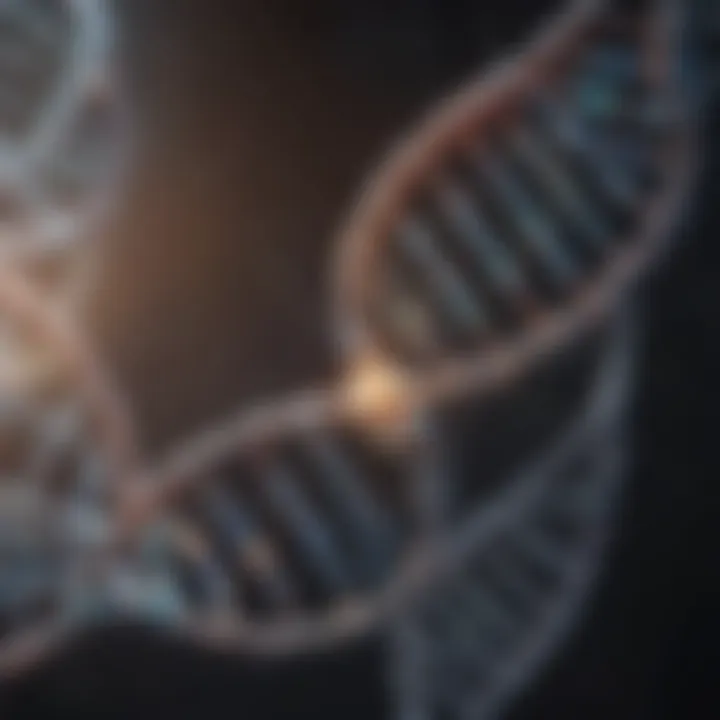Comprehensive Overview of DNA Testing and Its Impacts


Intro
DNA testing has transformed our understanding of genetics and its applications across various fields. This methodology plays a crucial role in healthcare, genealogy, and forensic science.
Through this article, we will explore the nuances of DNA testing, examining how it works, the different testing methods available, and the ethical considerations that accompany this powerful technology. By understanding these components, readers can better appreciate the broad implications of genetic testing in today's society.
Methodology
Overview of research methods used
DNA testing employs various scientific approaches to analyze genetic material. The primary methodologies include:
- Polymerase Chain Reaction (PCR): This technique amplifies small segments of DNA, making it easier to analyze.
- Next-Generation Sequencing (NGS): NGS allows for the sequencing of entire genomes quickly and cost-effectively, providing extensive genetic information.
- Short Tandem Repeat (STR) Analysis: Often used in forensic applications, STR analysis examines specific regions of DNA that vary among individuals, aiding in identity verification.
These methods enable researchers to obtain detailed genetic profiles for various applications.
Data collection techniques
Data collection in DNA testing often follows a systematic approach:
- Sample Acquisition: Biological samples such as blood, saliva, or cheek swabs are collected.
- Laboratory Processing: Samples are processed in controlled environments to extract DNA for analysis.
- Data Analysis: Advanced software tools help analyze the genetic data, identifying variations and patterns.
In forensic science, chain of custody is maintained to ensure the integrity and reliability of the DNA evidence used in legal contexts.
Future Directions
Upcoming trends in research
As we move forward, there are several exciting developments in the field of DNA testing:
- Personalized Medicine: Tailoring medical treatments based on an individual's genetic makeup is becoming a focus, with DNA tests guiding drug therapy choices.
- CRISPR Technology: Advances in genetic editing promise to revolutionize how diseases are treated by enabling precise modifications at the DNA level.
Areas requiring further investigation
However, several areas need further research to address ethical and practical challenges:
- Privacy Concerns: The implications of DNA data storage and sharing require thorough discussions to safeguard individuals' privacy rights.
- Ethical Considerations: As we learn more about genetic predispositions, ethical dilemmas around genetic discrimination and informed consent arise.
"The advancements in DNA testing hold immense potential but require careful considerations to ensure responsible use of genetic data."
This comprehensive overview encapsulates the intricate landscape of DNA testing, ensuring that readers are well-informed about its methodologies, current trends, and ethical implications.
Understanding DNA Testing
DNA testing plays a crucial role in various fields, including healthcare, genealogy, and legal matters. It allows for the examination of genetic material to uncover information that may be hidden within an individual’s DNA. This knowledge is significant, as it can impact personal health choices, familial connections, and even criminal investigations.
Understanding DNA testing involves grasping the basic principles of genetics. It explains how unique genetic sequences can define individuals. Additionally, it highlights the methodologies used in testing, the implications of the results, and the ethical considerations that come with genetic information. This foundation provides insights into the relevance of DNA testing in navigating complex decisions regarding health and ancestry.
What is DNA?
DNA, or deoxyribonucleic acid, is the hereditary material in humans and almost all living organisms. It carries the genetic instructions necessary for growth, development, functioning, and reproduction. Each strand of DNA consists of two long chains of nucleotides twisted into a double helix. These sequences of nucleotides are responsible for coding the biological traits of an organism.
Historical Background of DNA Testing
The journey into DNA testing began in the 20th century, primarily with the discovery of the DNA structure by James Watson and Francis Crick in 1953. This marked a pivotal moment in understanding genetics. The first application of DNA profiling occurred in the 1980s by Sir Alec Jeffreys. His work on genetic fingerprinting paved the way for using DNA in criminal investigations and paternity testing. Since then, the field has evolved, integrating advancements in technology and methodologies.
Types of DNA Tests
DNA testing can be categorized based on the type of genetic material analyzed. Different tests provide unique information relevant to ancestry, personal health, or forensic evidence.
Autosomal DNA Testing
Autosomal DNA testing examines the autosomes, which are the chromosomes that do not determine sex. This type of testing provides insights into an individual's ancestry by identifying genetic relationships through shared DNA segments. It is one of the most commonly used tests for genealogical purposes. Its popularity arises from being able to trace lineage from both maternal and paternal lines. A key feature of this test is its ability to provide ethnicity estimates, enabling individuals to explore their heritage. However, it may not reveal detailed ancestral information beyond recent generations.


Y-DNA Testing
Y-DNA testing focuses specifically on the Y chromosome, which is passed from father to son. This type of testing is valuable for tracing male lineage. The primary characteristic of Y-DNA testing is its ability to establish paternal ancestry, which can be beneficial for genealogists studying surname lineages. A unique feature of Y-DNA testing is that it is limited to males, offering information on direct paternal descent. While it provides important data, it does not provide insights into maternal lineage or broader ethnic histories.
Mitochondrial DNA Testing
Mitochondrial DNA (mtDNA) testing analyzes genetic material inherited only from the mother. This testing is useful for tracing maternal ancestry and can reveal the lineage of generations of women. One key characteristic of mtDNA testing is that it is not subject to the same recombination as autosomal DNA; thus, it generally remains unchanged. Its unique aspect allows people to track maternal ancestry back several generations with greater reliability. The disadvantage, however, is its limited scope in revealing the full breadth of an individual’s heritage compared to autosomal testing.
"DNA testing is a tool that reveals connections and information that can assist personal understanding of health, relationships, and ancestry."
Overall, comprehending the various types of DNA tests is instrumental for anyone looking to clarify their genetic background, whether for health reasons or genealogical interests.
Applications of DNA Testing
The applications of DNA testing are vast and impactful, significantly influencing fields such as healthcare, ancestry research, and forensic science. Each application carries its unique benefits and challenges, contributing to a growing interest in understanding DNA's role in personal and societal contexts.
Healthcare and Medical Diagnostics
Genetic Disorders
Genetic disorders are conditions caused by abnormalities in an individual's DNA. These disorders can vary widely in severity, symptoms, and inheritance patterns. DNA testing for genetic disorders allows healthcare providers to identify conditions early and offer targeted treatment plans. This proactive approach enhances the management of diseases such as cystic fibrosis, sickle cell disease, and Huntington's disease. Through genetic testing, individuals can gain insights into their health risks and make informed decisions regarding lifestyle and medical interventions.
The key characteristic of genetic disorders highlighted by DNA testing is its ability to detect specific mutations responsible for these conditions. This is particularly beneficial in cases where family history is unclear. However, there are disadvantages, such as the emotional implications of receiving a diagnosis and accessibility issues for those in remote areas. Understanding genetic disorders offers significant insights into personal health and potential family planning considerations.
Pharmacogenomics
Pharmacogenomics explores how genes affect an individual's response to medications. This branch of medicine aims to create tailored treatment plans that enhance efficacy while minimizing adverse effects. Personalized medicine has gained traction due to the potential for optimizing drug therapies based on genetic profiles.
The unique feature of pharmacogenomics is its focus on tailoring medications to an individual’s genetic makeup. By identifying variations in genes that influence drug metabolism, healthcare providers can select the most effective therapies for their patients. Despite its promising advantages, challenges remain, including the need for extensive research and data on gene-drug interactions. Integrating pharmacogenomics into clinical practice holds the potential to transform treatment paradigms.
Ancestry and Genealogy
African Ancestry Testing
African ancestry testing delves into the genetic lineages of individuals with African heritage. This type of testing helps to uncover geographical origins and migration patterns of ancestors, providing a more comprehensive view of one’s heritage. Such insights can foster a stronger connection to cultural identity and history.
The significant aspect of African ancestry testing is its ability to connect individuals to specific ethnic groups across the African continent. This benefit is notable for those who may feel disconnected from historical narratives due to the legacies of colonization and forced migration. However, the results may vary in accuracy, as many testing companies rely on a database that might underrepresent certain African populations. Therefore, while it can be enlightening, users should approach findings with a critical mindset.
Ethnicity Estimates
Ethnicity estimates provide a summary of an individual’s genetic heritage by comparing their DNA to reference populations around the world. These estimates can reveal a rich tapestry of ancestry that extends beyond commonly known family backgrounds.
The key characteristic of ethnicity estimates is their broad applicability, permitting individuals to explore links to diverse parts of the world. While this can be motivating for personal journey, results can sometimes be ambiguous. Different testing companies may yield conflicting findings due to varying methodologies and databases. Thus, while ethnicity estimates contribute to self-discovery, they should be interpreted cautiously.
Forensic Science
Crime Scene Analysis
Crime scene analysis utilizes DNA testing to identify biological evidence left at crime scenes. This application is crucial for criminal investigations, as it links suspects to various locations and moments in time. By analyzing DNA samples, forensic experts can determine identity, thereby providing law enforcement with a powerful tool in the quest for justice.
The significant benefit of DNA in crime scene analysis lies in its precision and reliability. Unlike many forms of evidence that can be circumstantial, DNA conclusively connects individuals to a specific incident. However, challenges exist, including contamination risks and the interpretation of degraded samples. Effective crime scene analysis, bolstered by DNA technology, can enhance the prosecutorial process and ensure the proper adjudication of cases.
Identifying Remains
Identifying remains using DNA is critical in many contexts, especially when dealing with cases of missing persons or disaster victims. DNA profiling can assist in matching remains with living relatives, providing closure to grieving families. The ability to draw definitive conclusions based on DNA evidence is unparalleled in forensic science.
The unique feature of this application is its invaluable role in humanitarian efforts, especially post-disasters. However, the process can raise ethical concerns about consent and the handling of sensitive information. Even so, the precision involved in identifying remains is a necessity in various investigative domains, providing answers to unresolved questions.
DNA testing continues to evolve, bringing remarkable changes across multiple sectors, affirming its significance in healthcare, ancestry research, and forensic science.
Methodologies in DNA Testing
Understanding the methodologies in DNA testing is critical for grasping how genetic analysis is conducted. These techniques lay the foundation for accurate, reliable results and have significant implications across various fields such as healthcare, genealogy, and forensic science. Without precise methodologies, the value of DNA testing could be severely diminished. Therefore, exploring sample collection techniques and laboratory analysis is essential for anyone interested in the depths of genetic science.


Sample Collection Techniques
Blood Samples
Blood samples are one of the most traditional methods for DNA collection. They are often favored due to their ability to provide a high yield of genetic material. The process typically involves drawing blood from a vein, which can be done in a clinical setting. A key characteristic of blood samples is their richness in cellular DNA. This makes them particularly valuable when analyzing complex genetic information.
The use of blood samples has been a longstanding practice for DNA testing because they allow for a detailed examination of genetic markers without much contamination. However, the invasive nature of this method can deter some individuals from providing samples. In addition, blood sample collection requires trained professionals, which can increase costs and logistical challenges. Nevertheless, the advantages of high reliability and detailed results make blood sampling a popular choice for serious genetic investigations.
Saliva and Buccal Swabs
Saliva and buccal swabs have gained popularity in recent years due to their non-invasive nature. These samples can be easily collected by either swabbing the inside of the cheek or spitting into a tube. A key feature of saliva and buccal swabs is their convenience, allowing individuals to collect samples privately and comfortably.
This method is beneficial as it reduces the need for healthcare professionals, streamlining the testing process. However, some might argue that saliva samples can provide lower DNA yield compared to blood. Still, advancements in technology have improved the reliability and effectiveness of saliva and buccal swabs in providing accurate genetic data. Overall, their ease of collection makes them an advantageous option for many.
Laboratory Analysis
Polymerase Chain Reaction (PCR)
PCR, or Polymerase Chain Reaction, is a cornerstone technique in DNA analysis. It enables scientists to amplify small segments of DNA, making it possible to analyze even minute samples. The importance of PCR lies in its ability to generate enough genetic material for detailed examination, which is essential in many testing applications.
The primary advantage of PCR is its speed and sensitivity. In a matter of hours, it can produce millions of copies of a targeted DNA sequence. This is especially useful in various fields, from forensic science to genetic research. However, PCR can be prone to contamination, which could lead to erroneous results. Careful technique and controlled environments are, therefore, critical in obtaining reliable data.
DNA Sequencing
DNA sequencing determines the exact order of nucleotides in a DNA molecule. This technique is essential for identifying genetic variations and understanding complex genetic structures. One of the key benefits of DNA sequencing is its ability to provide a comprehensive overview of an individual's genetic makeup, offering insights that other methodologies may not capture.
The rapid advancements in sequencing technology have made it a popular option for both research and clinical applications. However, the complexity and cost associated with this process can be limitations. Sequencing can also generate vast amounts of data, which requires careful analysis and interpretation to be of value. Nevertheless, its distinct advantage in providing detailed information about genetic materials makes it indispensable in modern DNA testing.
Accuracy and Reliability of DNA Testing
Accurate DNA testing is paramount in ensuring that the results yield valid conclusions. The reliability of these tests impacts various fields, including healthcare, genealogy, and forensic science. A precise understanding of accuracy helps in achieving meaningful insights regarding genetic information, hereditary conditions, or even ancestry. Additionally, a reliable testing methodology enables researchers, medical professionals, and individuals to make informed decisions based on DNA data.
A significant factor driving the exploration of DNA testing accuracy is the implication it has on decisions related to health risks, relationships, and legal matters. Misinterpretation or inaccuracy can lead to inappropriate health interventions, misplaced trust in genealogical links, or unjust legal outcomes. Therefore, discussing the underlying factors that influence test accuracy is essential.
Factors Affecting Test Accuracy
The accuracy of DNA tests can be influenced by various elements, which must be understood clearly.
- Quality of Sample: The initial sample collected has a major role. Contamination or degradation can severely undermine test results.
- Testing Methodology: Different methodologies may yield varying results, such as Polymerase Chain Reaction versus whole-genome sequencing. The choice of technique is critical in determining accuracy.
- Laboratory Protocols: Consistency in laboratory practices ensures reliable outcomes. Laboratories must adhere to standard operations to minimize errors.
- Interpretative Guidelines: The frameworks used by geneticists to interpret data also affect accuracy. Different interpretations may lead to divergent conclusions from the same raw data.
Attention to these influences is crucial in advancing the understanding of DNA testing. A thorough grasp of potential inaccuracies can guide individuals when choosing testing services.
Interpreting DNA Test Results
Understanding how to interpret DNA test results is vital for making meaningful conclusions. Results are often complex and require thoughtful analysis to avoid misconceptions.
Understanding Genetic Markers
Genetic markers serve as biological landmarks used to track inheritance patterns and can provide insights into an individual's ancestry and health risks. These markers are specific sequences in DNA that vary among individuals. Their utility lies in their ability to correlate with certain traits or conditions.
Key characteristics include:
- Diversity: A vast range of genetic markers can reveal different attributes.
- Specificity: Some markers are focused on single traits or disorders, making them valuable in targeted testing.
The use of genetic markers contributes to the accuracy of test results, helping to refine the interpretations offered by laboratories. However, not all markers are equally informative, and reliance on a few can be limiting.
Limitations of Results
Despite advancements in DNA testing, limitations exist that must be acknowledged. These limitations can affect the validity of conclusions drawn from the results.
Key factors include:
- Incomplete Information: Tests may not provide a comprehensive picture of one’s genetic landscape due to the selection of tested markers.
- False Positives/Negatives: Misread data can lead to incorrect health assessments or ancestry relationships.


Recognizing these limitations is essential for researchers and consumers alike. A critical approach to interpreting results is necessary to mitigate the risks associated with false interpretations.
Ethical and Privacy Considerations
Ethical and privacy considerations stand as pivotal aspects of DNA testing. As technology advances, concern for individuals’ rights and the ethical use of genetic data grows. This topic evokes numerous discussions surrounding informed consent, data ownership, and potential risks of genetic discrimination. Recognizing these factors is essential not only for practitioners but also for individuals seeking DNA tests. Understanding the implications of these considerations encourages a responsible approach to genetic testing.
Informed Consent
Informed consent is a fundamental principle in any medical or scientific procedure, including DNA testing. It refers to the process where individuals are fully educated about what the test entails, its purposes, risks, and potential uses of their genetic information. When individuals agree to participate, they must do so with a clear understanding of how their data will be used and stored.
- Clarity and Transparency: Providers should present information straightforwardly, ensuring participants comprehend the implications of their consent.
- Withdrawal of Consent: Participants maintain the right to withdraw their consent at any point. Difficulty in exercising this right raises ethical concerns regarding participant autonomy.
- Scope of Use: Participants should be informed whether their data will be used for research, shared with third parties, or archived long-term. Clarity on these issues reduces misunderstandings and fosters trust.
Data Ownership and Sharing
With the rise of DNA testing, questions about data ownership have emerged. Individuals typically assume they own their genetic data upon testing. However, the reality can be more complex.
- Ownership Claims: Many testing companies include clauses in their terms of service that allow them to retain rights over the data. This means that individuals may not possess full ownership of their genetic information.
- Data Sharing Practices: Companies often share anonymized data with researchers or partner organizations. Transparency regarding these practices is vital to ensure individuals are aware of how their data might contribute to broader research initiatives.
- Legal and Ethical Frameworks: Varying regulations across jurisdictions impact how data is treated, making it imperative for individuals to read and understand these terms fully.
Potential for Genetic Discrimination
Genetic discrimination is a concerning issue in the field of DNA testing. As more individuals opt for genetic testing, the risk of discrimination increases based on genetic predispositions.
- Employment and Insurance: Individuals might face discrimination from employers or insurers who could deny opportunities or coverage based on perceived genetic risks. This creates a chilling effect that discourages individuals from undergoing potentially beneficial genetic tests.
- Legislative Protections: Some countries have enacted laws to protect against genetic discrimination, but not all jurisdictions offer such protections. Understanding the local legal landscape is essential for informed decision-making regarding genetic testing.
- Public Awareness: Raising awareness about the possibilities of genetic discrimination is crucial. Individuals and organizations must advocate for policies protecting against such practices to create a safe environment for genetic testing.
Ethical considerations in DNA testing are not merely technical issues; they reflect society’s values regarding privacy, autonomy, and equality.
As DNA testing becomes more commonplace, it is essential to remain vigilant regarding ethical and privacy considerations. Engaging with these topics will help ensure a transparent and equitable approach to genetic testing.
Future Trends in DNA Testing
The field of DNA testing is undergoing rapid transformation, driven by technological advancements and changes in consumer demand. This section highlights the significance of future trends in DNA testing, emphasizing specific elements, benefits, and considerations. Understanding these trends can guide students, researchers, and professionals in anticipating changes and adapting strategies in their respective areas.
Advancements in Technology
Recent technological advancements are reshaping DNA testing processes. One notable innovation is the reduction in sequencing costs. Next-generation sequencing (NGS) allows for faster and more affordable genetic analyses than traditional methods. This accessibility encourages more widespread use in not only research settings but also in clinical environments.
Another advancement is the implementation of CRISPR technology. CRISPR offers the potential for more detailed genetic modifications and personalized medicine solutions. This could lead to significant improvements in screening for genetic disorders. The combination of these technologies is making it easier to conduct more comprehensive analyses, resulting in richer data outputs that enhance understanding of genetic impacts on health.
The integration of artificial intelligence (AI) is also emerging as a critical player in DNA testing. AI can facilitate better interpretations of DNA data, providing clearer insights into genetic predispositions and associated traits. These advancements may lead to earlier detection of genetic conditions, allowing for preventive measures to be taken.
Market Growth and Accessibility
As technology evolves, the market for DNA testing continues to expand. The industry is witnessing significant growth due to increasing consumer interest in health, ancestry, and forensic genetics. Personalized healthcare is a major driving force; individuals are seeking ways to understand their own genetic information. This demand is propelling investments in research and the development of innovative testing solutions.
Accessibility is also a crucial factor. Many companies are actively working to lower the barriers to entry for genetic testing. This includes making tests more affordable and easier to access through online platforms. The rise of direct-to-consumer testing services has made genetic insights available to a broader audience. This trend creates an environment where more people can engage with their genetic information, promoting awareness and education on genetic topics.
Moreover, the potential for regulatory changes may facilitate market growth. As governments recognize the value of genetic testing in medical diagnostics and public health, more supportive policies may emerge. This could further legitimize the DNA testing industry and enhance its overall credibility in scientific and healthcare communities.
"With emerging technologies and the expanding market, the realm of DNA testing is poised for significant evolution, impacting various aspects of society and healthcare."
In summary, the future of DNA testing is characterized by rapid advancements and increasing accessibility. These trends not merely enhance the capabilities of genetic testing but also democratize information access, empowering individuals to gain deeper insights into their genetics.
Ending
The conclusion of this article synthesizes the various elements surrounding DNA testing for a holistic understanding of its significance. In recent years, DNA testing has seen monumental advancements, significantly influencing healthcare, genealogy, and forensic science. The ability to unlock genetic information creates both opportunities and challenges, thus warranting careful consideration of various implications.
Recap of Key Insights
In summary, DNA testing encompasses diverse methodologies and applications. Some pivotal points discussed include:
- Types of DNA Tests: There are several types, including autosomal, Y-DNA, and mitochondrial testing. Each serves unique purposes, catering to different investigative scenarios.
- Applications: From medical diagnostics to ancestry exploration and forensic analysis, DNA testing has established its relevance across various sectors.
- Accuracy and Reliability: Understanding the factors affecting accuracy and how to interpret results is essential. Recognizing limitations is crucial to avoid misconceptions and ensure informed decisions.
- Ethics: Issues of informed consent, data ownership, and potential genetic discrimination have emerged as crucial ethical considerations in DNA testing.
These insights lay the foundation for understanding the broader implications of genetic testing and its increasing role in society.
Implications for the Future
The implications of DNA testing extend beyond scientific curiosity. As technology advances, the accuracy and affordability of tests continue to improve. This trend is likely to make DNA testing more accessible to a broader audience, transforming various fields:
- Healthcare: Personalized medicine could evolve, tailoring treatments based on individual genetic profiles.
- Genealogy: With more accessible testing, family history exploration may become commonplace, reshaping personal identities.
- Regulation and Governance: As data privacy concerns grow, the legal framework surrounding genetic information may tighten, leading to better protections for individuals.







